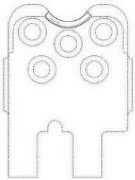In Flexible Steel Lacing Co. v. Conveyor Accessories Inc.,1 the Seventh Circuit Court of Appeals ruled that a conveyor belt fastener’s “beveled center scallop” design was not entitled to trade dress protection because it was utilitarian.
Flexible Steel Lacing Co. (Flexco) and Conveyor Accessories Inc. (CAI) were competitors in the belt conveyor industry. Belt conveyors are used in a wide variety of material handling applications, ranging from transporting coal from a mine shaft to moving groceries at the checkout lane. Many belt conveyor systems employ an endless flexible rubber belt comprised of multiple high-strength rubber belt segments that are spliced together, and mechanical belt fasteners can be used to splice the segments together.
In 1999, Flexco introduced the Scalloped Edge™ fastener, a mechanical belt fastener featuring leading edges that are scalloped. “Compared to a straight-edged fastener, the Scalloped Edge™ fastener displaces and compresses less rubber when it is installed because less plate material is being imbedded in the belt,” the court said.
Flexco received utility and design patents for the fastener. After the patents expired, Flexco applied for and received federal trade dress protection for the fastener’s beveled center scallop. Flexco’s U.S. Trademark Registration No. 4,971,326 (Flexco’s registered trade dress, or the beveled center scallop) claimed only the beveled concave curve of the leading edge, as indicated by the darkened outline border in the illustration below:

Flexco sued CAI for trade dress infringement based on fasteners that Flexco said were confusingly similar to its trade dress. CAI argued the design was not eligible for trade dress protection because it was functional. The district court agreed with CAI, and the Seventh Circuit affirmed.
If a product’s functional feature were permitted to be used as a trademark, competition would be unduly stifled because a trademark can be “renewed in perpetuity,” the Seventh Circuit observed. Five factors are generally considered in the determination of whether a design is functional:
(1) the existence of a utility patent, expired or unexpired, that involves or describes the functionality of an item’s design element; (2) the utilitarian properties of the item’s unpatented design elements; (3) advertising of the item that touts the utilitarian advantages of the item’s design elements; (4) the dearth of, or difficulty in creating, alternative designs for the item’s purpose;...
